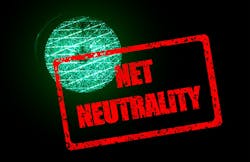Will the Internet of Things Survive Without Net Neutrality?
Do you have the next greatest idea for the Internet of Things (IoT)?
More than likely, it depends on one or more communication links. Many already employ smartphones or tablets as control or gateway devices. Of course, the internet plays a part in the solution, with most management and data analysis being done in the cloud. This all works because communication throughout the internet has been relatively neutral until now.
The changing political climate in the U.S. is likely to trash the idea of net neutrality. This could impact many plans for IoT. If the internet becomes Balkanized, then many IoT solutions may not work and existing systems could be significantly degraded.
So, how would any of this happen?
To start with, the changes coming in the Federal Communication Commission (FCC) will likely gut the current state of affairs and derail items like the opening of the set-top-box market. Customers have fewer options, if any, for internet service providers (ISPs). And reducing the options for connectivity by restricting hardware even more than what’s currently happening will limit IoT developers’ choices for connecting their devices to the cloud.
Mounting Costs and Complexity
Hardware is just one aspect. Protocols, bandwidth, and quality of service (QoS) are in the hands of the ISP, and restricting these is one way to be able to charge more. Likewise, ISPs these days are usually content providers as well. Restricting the competition, including IoT-related services, is much easier to do when you own the pipes and have a competing service. Even where an ISP doesn’t have a service, it can easily make money by providing partners with advantageous access.
Like insurance and healthcare, the actual costs to IoT providers and their customers will probably be hidden behind a billing wall that will make most lawyers and accountants cringe when trying to analyze a bill—if that’s even possible.
Navigating the costs is likely to be less aggravating than debugging an increasingly complex communication system. Try to figure out where an IoT communication problem lies when multiple devices, gateways, and communication paths are involved, and those pathways now have different modes of operation based on what contracts are signed. It’s quite manageable for a single instance, but consider the challenges when millions of devices are in play for a particular service or vendor.
Of course, this is an opportunity for ISPs to sell more “services” to developers and purveyors of network services. Never mind that the bits going across the pipe don’t care what they are. Just consider the printer-ink market, in which vendors try to force users to only buy their ink. Imagine the same scenario for cars and gasoline. The restrictions are a lot easier to put in place when you control the pipes.
Video content is already restricted and standardized with HDMI. At this point, only one of my DVRs can record most things and the other only about half. The latter actually has a cable card, but that’s not enough for many channels.
Part of the net-neutrality issue is the switching system that is the internet continues to get much smarter. Analysis of not just a packet, but longer-term communication, is possible for filtering and optimization purposes. It’s a trivial exercise to route one class of traffic in one direction and a different class in another. Just imagine Uber having to use one set of streets while taxis get another. Filtering can even be done based on the time of day, the color of the car, or number of passengers. It’s harder with cars, but trivial with bits.
In theory, open markets and competition are supposed to be good at reducing prices and increasing service options. It’s a great idea, but no way applicable to the current open internet discussion being dominated by a few companies that have essential monopolies in many areas.
Most developers don’t have the time, inclination, or reason to address the transport management issues involved with net neutrality. However, they must make assumptions and address issues to make products work. Their job is going to get much more complex.
About the Author
William Wong Blog
Senior Content Director
Bill's latest articles are listed on this author page, William G. Wong.
Bill Wong covers Digital, Embedded, Systems and Software topics at Electronic Design. He writes a number of columns, including Lab Bench and alt.embedded, plus Bill's Workbench hands-on column. Bill is a Georgia Tech alumni with a B.S in Electrical Engineering and a master's degree in computer science for Rutgers, The State University of New Jersey.
He has written a dozen books and was the first Director of PC Labs at PC Magazine. He has worked in the computer and publication industry for almost 40 years and has been with Electronic Design since 2000. He helps run the Mercer Science and Engineering Fair in Mercer County, NJ.
- Check out more articles by Bill Wong on Electronic Design
- Bill Wong on Facebook
- @AltEmbedded on Twitter


